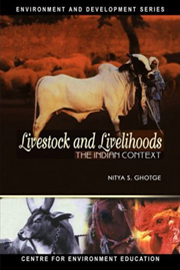Book contents
- Frontmatter
- Foreword
- Acknowledgements
- Contents
- Preface
- Chapter 1 The Beginning …
- Chapter 2 Patterns of Livestock rearing
- Chapter 3 Traditional Practices in Animal Rearing
- Chapter 4 Emerging Trends in Livestock Rearing
- Chapter 5 It must not End: Towards an Alternative Policy
- Chapter 6 Reorienting Ourselves
- Chapter 7 Framework for An Alternate Policy
- References
- Index
Chapter 6 - Reorienting Ourselves
Published online by Cambridge University Press: 26 October 2011
- Frontmatter
- Foreword
- Acknowledgements
- Contents
- Preface
- Chapter 1 The Beginning …
- Chapter 2 Patterns of Livestock rearing
- Chapter 3 Traditional Practices in Animal Rearing
- Chapter 4 Emerging Trends in Livestock Rearing
- Chapter 5 It must not End: Towards an Alternative Policy
- Chapter 6 Reorienting Ourselves
- Chapter 7 Framework for An Alternate Policy
- References
- Index
Summary
A change in existing systems would require reorienting the way we look at animals, their herders and the healers. It would also require reorienting the programmes designed for them, the interventions planned for them and the way the policies have been formulated.
Reorienting Programmes
Planning with people
When we talk about diversity of systems, it also becomes important to consider the preferences of people living in an area. While a common criticism of our farmers is that they over-stock poor quality animals, and should instead keep few good quality animals, our livestock development schemes are often guilty of promoting the same. Schemes are designed where landless farmers can avail of credit for keeping units of 10 cross-bred dairy cows or 50 goats. Although great care is apparently taken to calculate every last detail they often miss the one major component, which is feed. Landless farmers cannot grow fodder and are therefore dependant on buying fodder if their unit is to succeed. If for some reason the production does not match up to their expectations due to illness, accident, death, which is quite often, the units become non-viable. Schemes are also designed for women from poor households, where the different inputs of fodder, labour and veterinary care are not in place. Market linkages are also weak.
Unfortunately, financial institutions only give credit for schemes designed by them and seldom listen to what people want. Farmers often want very little credit for purchasing one animal or a few chicken.
- Type
- Chapter
- Information
- Livestock and LivelihoodsThe Indian Context, pp. 108 - 121Publisher: Foundation BooksPrint publication year: 2004

